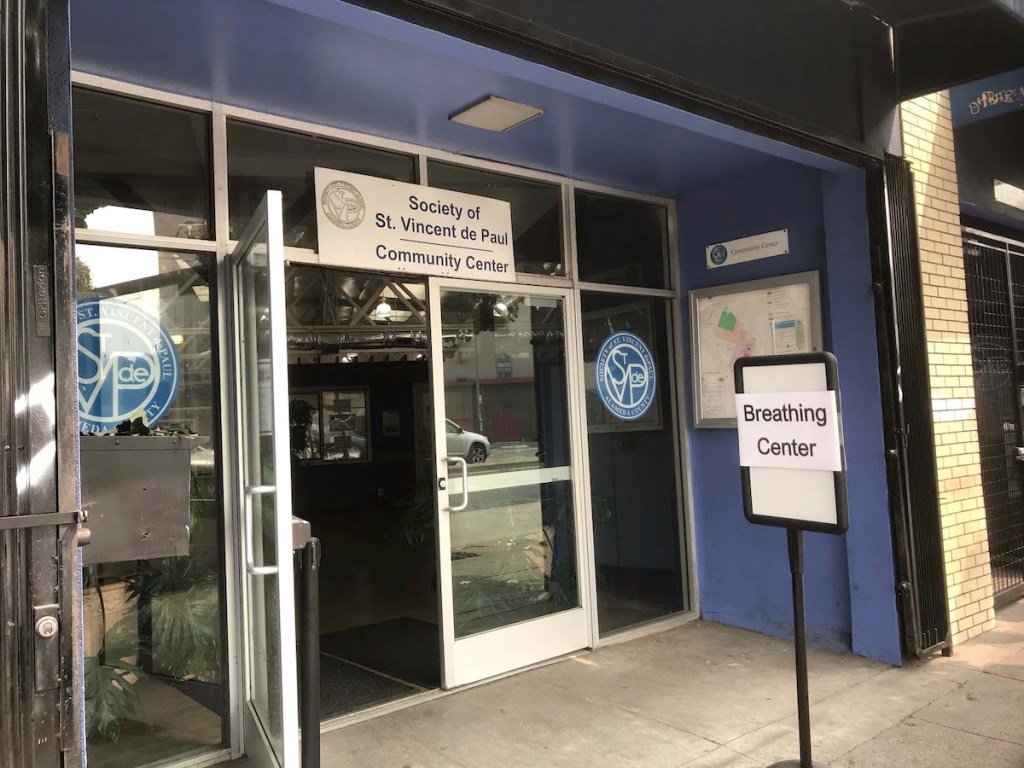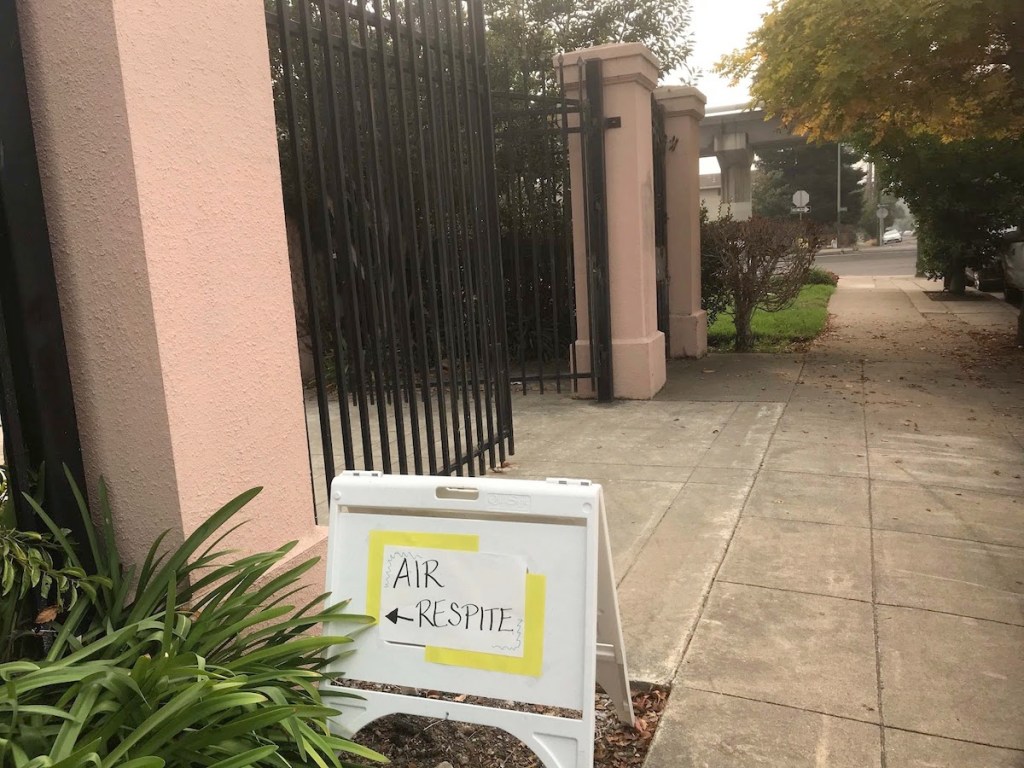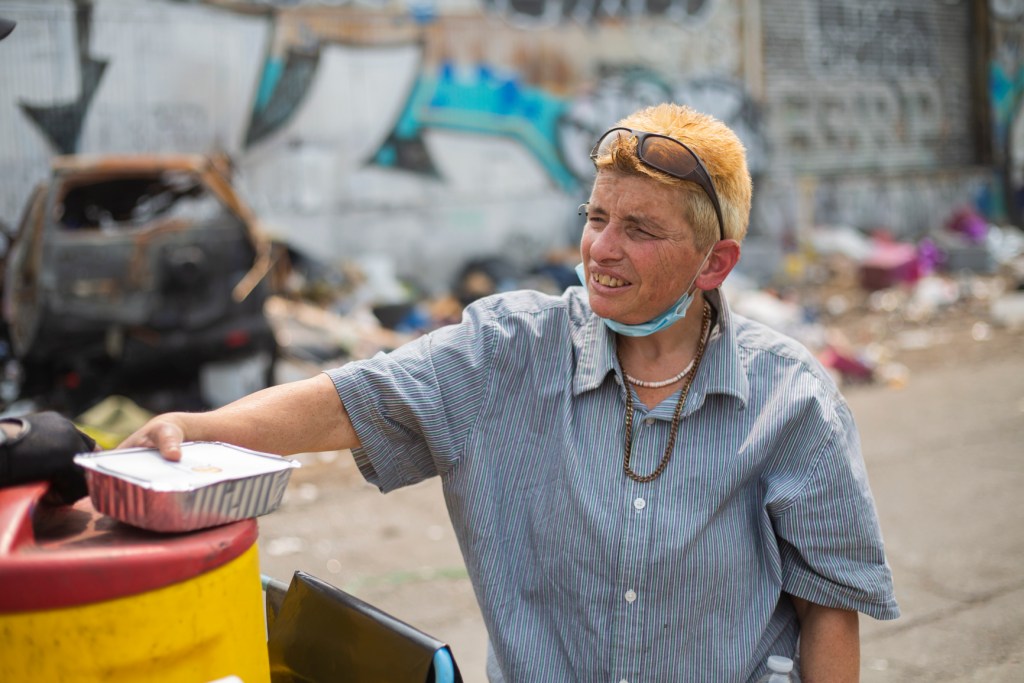At the “giraffe park” homeless camp below the 580 freeway at Harrison Street, the tents, bikes, and tables lining the underpass were all covered in layers of white ash Saturday morning.
“I get headaches,” said Patricia Densby, who’s lived at the camp for a year and a half. “My eyes be itching. When I woke up the other day I thought it was nighttime,” she said, after smoke made the sky turn dark orange.
Oakland’s air was dangerously polluted that day with particulate matter from fires raging across California and Oregon. The air quality had reached levels deemed “unhealthy” for the general population by the U.S. Environmental Protection Agency. Advice from public health officials was clear: Stay inside.
But for residents like Densby and the other 4,000 or so people who don’t have a permanent, indoor home in Oakland, that’s nearly impossible to do.
What Densby and her neighbors didn’t know was that the city had opened “clean air respite centers” in North and East Oakland the day before, where residents could sit down and inhale some fresh air for a couple hours.
Two centers, at the North Oakland Senior Center and Dimond Library, opened starting Friday. The city’s clean air facilities dashboard currently says the two sites are still open, despite staff saying at a City Council meeting that all centers closed after the weekend. An additional two centers, at the 81st Avenue Library and St. Vincent de Paul, were open this past Saturday and Sunday as well.
On Friday and Saturday, paper signs with the words “air respite” and “breathing center” pointed toward the North Oakland Senior Center and St. Vincent de Paul. But there were no other signs or information about these facilities. There also weren’t any staff out front to answer questions.
Critics say the city acted too late, and didn’t do enough to help Oakland residents who needed access to the clean air. The virtually empty facilities also suggest the city might not have done enough to spread the word to people who could have benefited. Few Oaklanders knew about the centers while they were open.
City leaders say staff scoured the town for the few public buildings that could provide clean air and still allow visitors to social-distance. This is the first time Oakland has opened such facilities, and staff said it was a logistical feat to get them up and running. They chose site locations that would be accessible for vulnerable residents, they said.
With weeks of wildfire season ahead of us, and a deadly pandemic still raging, is the city ready to keep more of its residents safe during future emergencies?
City official started pushing for clean-air shelters in July
On July 28, a fire in San Francisco destroyed multiple buildings and sent smoke shooting into the East Bay where it hovered over Oakland.
That day, City Council President Rebecca Kaplan emailed City Administrator Ed Reiskin asking about plans for “clean air options” in Oakland in the coming weeks.
“As you know, wildfire season is expected to grow,” Kaplan wrote in an email. “With most public buildings closed, what is the plan in terms of where people can go, including those who are unhoused, on days of high smoke/poor air quality?” Kaplan made a similar comment at a council meeting that day.
Reiskin wrote back quickly to say the city was “wrapping up plans” for clean air shelter options.
A few weeks later, lightning set off fires across California, causing plumes of smoke to fill the skies and cover Oakland again in dangerous smog. This time the pollution would last much longer than it did that day in July.
On Aug. 26, after several days of poor air quality in Oakland, Kaplan put out a statement asking why no clean-air centers had opened.
In response to a request from Kaplan, the city administration produced a report on Sept. 3 describing its plans for clean-air and cooling centers. According to the report, the city was waiting on certain air-quality and temperature “triggers” to be met before opening the clean air centers. The report, written by Interim Fire Chief Melinda Drayton, said the city planned to open clean-air centers when the air quality index reached 250, or “very unhealthy,” and to open cooling centers when the temperature is 95 degrees for three days straight, or 100 degrees on a single day.

On Sept. 9, Kaplan criticized the report in a letter to Reiskin that she shared on social media. She wrote that the report “appears to disclose that you have not opened any clean air buildings despite many days of heavy smoke and high heat, and from the report, we cannot tell if you have any plans to open any, nor have you provided information about what is needed to open them…I am concerned that it appears you have created a standard for opening of such centers that is designed to actually not open them.”
Around the same time, members of the public began putting pressure on the city to open centers, too. Eventually the city opened the two respite sites on Friday, Sept. 11, without advance warning. The city administration said that staff had been monitoring air quality all along and sprung into action when the AQI reached 245. Kaplan said they acted too late.
“It doesn’t take a prophet to have seen months ago that this was going to be a bad fire season,” Kaplan said in an interview with The Oaklandside on Monday. “I asked for us to be prepared ahead of time. I’m not sure they understood how bad it was going to be.” It was clear, Kaplan said, that typical temporary respite options like movie theaters or libraries wouldn’t be available this year because of COVID-19 closures.
At Tuesday’s City Council meeting, Reiskin said staff has been “working extremely hard” on setting up the centers, but acknowledged the administration has “been playing a little bit of catch up.”
“We have not had, to be frank, a robust program and protocol for standing up shelters. I was a little surprised to find that,” said Reiskin, who just started working for Oakland this spring. Additionally, the pandemic presented a completely different health risk, and the city had to balance the dangers of bad air with the risks associated with traveling to, and congregating in, an indoor respite center, he said.
“This is the City’s first ever activation of clean air respite centers and the time between making the decision to activate and opening our doors was extremely quick,” said city spokesperson Autumn King, in an email to The Oaklandside.
The county’s public health department assists cities in opening clean-air and cooling centers, said spokesperson Neetu Balram, in an email. The county has provided COVID-19 safety protocols for the centers, for example. Cities in Alameda County have opened several cooling sites, but there have been none in Oakland despite record-breaking heatwaves.

“As the heatwaves and wildfires were becoming an issue, we provided guidance related to cooling centers that also applies to clean-air centers,” said Dr. Michael Stacey, a physician consultant for Alameda County. But the county doesn’t verify that its guidance is followed, he said.
“We’re not able to go in and evaluate every facility and make sure that it has HEPA filters, nor do we have the expertise to do that,” said Stacey.
Stacey said he “can’t really speak to the delays in opening the clean-air respite centers because it’s not the health agency that’s opening the centers, but the cities.”
Almost nobody used the centers
Oakland selected the North Oakland Senior Center and Dimond Library as the initial clean-air sites because of the high-quality air filtration systems there. Neither building’s air filters meet the highest, or HEPA, standards, as the only public buildings with those filters are current employee workspaces, according to the city. But the city said both sites, along with the Rockridge Library, have the next-best capacity to trap harmful particulate matter in the wildfire smoke.
Oakland opened the first two centers on the 25th consecutive day of Spare the Air alerts, which the Bay Area Air Quality Management District issues on days forecasted to have unhealthy air quality. This wildfire season has already produced poor air quality in the Bay Area surpassing that caused by the Camp Fire in 2018, which led to 14 Spare the Air alerts in a row.
The North Oakland Senior Center, near the Emeryville border, and the Dimond Library, on Fruitvale Avenue, both had the capacity to accommodate 20-25 people at a time over the weekend during the daytime hours the sites were open. But neither saw anywhere close to that number of visitors.
The senior center hosted a total of five people over the three days it was open, according to the city. The library had 10 guests.
Oakland resident Susan Abertelli was one of the two visitors to the library Friday. She said she happened upon the facility by chance and stayed for several hours.
“My friend and I walk everyday because where we live doesn’t have any air-conditioning,” said Abertelli, who lives at a nearby assisted living facility. The center “was marvelous. There’s a lot of us that really need this type of assistance.”
Oakland Public Library spokesperson Matt Berson said staff members posted fliers around the neighborhood, in places like Dimond Park. But he said more people could have benefited from the fresh air. “Just based on our food distribution numbers and the communities that we usually serve, there were more people that could take advantage of those respite centers,” he said.
On Saturday, Oakland opened its third and fourth clean-air respite centers in neighborhoods closer to dense homeless encampments.
The 81st Avenue Library in East Oakland is tucked inside of the Woodland neighborhood, fairly hidden from the main thoroughfare, International Boulevard. While able to accommodate 25 people, this site saw the fewest visitors, even though the library is just half a mile away from dozens of tents lining San Leandro Street.
The city closed that center early Saturday after nobody showed up. The next day, there was one visitor. King, the city spokesperson, said that going forward, staff will make “sure that people are visible even up to the last minute, so folks coming up know that there are bodies there” and that the building is open.
The other site that opened was St. Vincent de Paul, a nonprofit community center serving vulnerable individuals. The center, located at 2272 San Pablo Ave., could accommodate 25 people and was the only site where visitors were allowed to eat and drink.
Despite sitting directly across the street from large camps on San Pablo Avenue, St. Vincent de Paul logged just one visitor when it opened Saturday. The next day, the count rose to nine, the most any of the respite centers saw in one day.
According to the city, “street teams” from the Human Services Department attempted to reach unsheltered communities around the four respite centers. Operation Dignity, a nonprofit providing homelessness services, conducted street outreach for the city, too, said King in an email. Yet the four sites only saw a total of 26 visitors over three days.

“We definitely wanted encampments that were around,” said King. “But we only had four [respite centers] open and that doesn’t cover the whole swath of Oakland.”
By Monday, some unhoused people at a large encampment by Lake Merritt on E. 12th Street still hadn’t heard about the clean-air centers.
“That would be great,” said Krystal Prater when told about sites.
Prater said the smoky air “makes you tired and sluggish.” She said positive things about the city’s response to her camp’s needs during the spate of recent crises. City workers come pick up trash regularly and keep the portable toilet clean and the soap dispenser filled, she said.
The residents do their part too. Prater said “it took forever” to shake the ash off the community’s tents and belongings. “We clean incessantly because living situations have to be clean,” she said, adding that she thanks the trees around her for helping clean the air too.
When and where will centers open next time?
At Tuesday’s council meeting, Kaplan said the city should have gotten the word out about the clean air center locations much sooner.
“People had no idea they’d be open—when, if, and where,” she told city staff. “Don’t wait until the middle of the day on a crisis day to say, ‘Here’s a couple of places.’”
Jessica Feil, Oakland’s new emergency manager, said outreach was significant, including through press releases on social media, but could have gone further. “Part of what we’re trying to do is have the same facilities be open every time, so people know where to go and what to turn to,” she said.
This week, Oakland seems to be getting a break from the suffocating air.
But “this problem isn’t going away,” Kaplan told The Oaklandside, citing dual climate and public health crises. She said Oakland should get more buildings set up for future use.
At Tuesday’s meeting, city staff said the administration is using grants and COVID-19 relief money to improve air filtering and conditioning in additional buildings, and get them equipped with backup energy for likely power shutoffs. There are already more options for simple cooling centers where air-conditioning is available, but hardly any sites are already set up to provide clean air, the city said.

“We do have next steps,” said Feil. The city has also been handing out masks to unhoused residents, Reiskin said.
Densby, the woman who lives at the Giraffe Park encampment, said unhoused residents need more than a couple hours of respite.
“Try to help them get an apartment, a motel or something, or affordable housing,” she said.
At the council meeting, Feil said the city is looking at options for overnight emergency shelters, including at the Oracle Arena and the Oakland Convention Center, but running into some logistical challenges.
Multiple councilmembers also questioned the city’s proposed “triggers” of 250 AQI and three days of 95-degree weather to open a respite or cooling center.
District 2 Councilmember Nikki Fortunato Bas said she’d been told by a climate expert that an AQI of 150 would be a more appropriate threshold. The EPA considers even an AQI of 101-150 “unhealthy for sensitive groups.”
Feil, the emergency manager, said the 250 marker was chosen “deliberately,” based on Berkeley’s protocols and to “balance exposing people to a potential public health threat, and providing relief from hazardous air.”
Staff will come back to the council with an update on Oct. 20, but will submit an informational report on the progress with respite plans before then.
At Tuesday’s meeting, the City Council also declared a local state of emergency due to the wildfires on the West Coast—a move Reiskin said will make Oakland eligible for federal and state emergency funding.
Kaplan said the city needs to do much more to prepare.
“We don’t wait until the fire starts to go hire firefighters,” she said. Clean-air and cooling centers need to be “part of our structural plan.”

